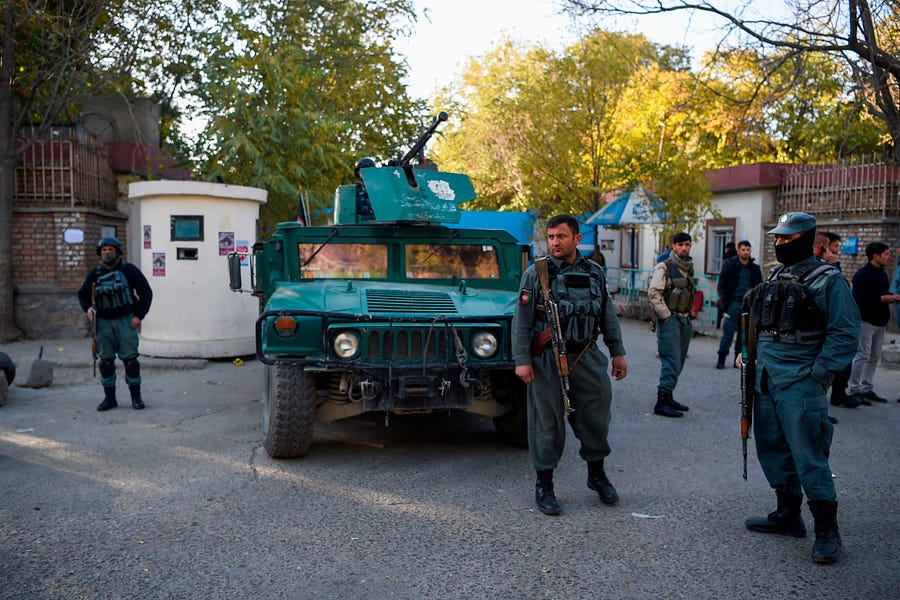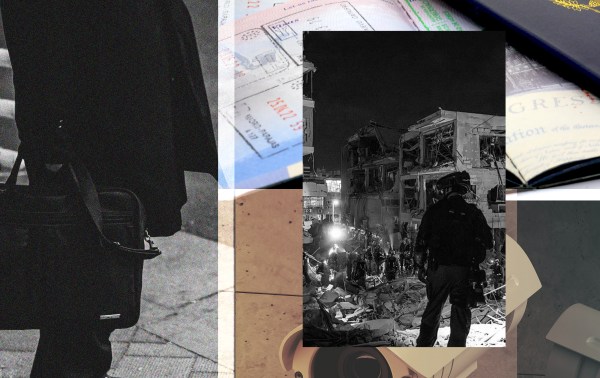It was perhaps a sign of things to come: Days before peace talks between the Taliban and the Afghan government began in September, a Taliban bombing in Kabul injured the country’s senior vice president, Amrullah Saleh, and killed 10 bystanders. The country remains in a state of limbo, and a terror attack on Kabul University last week killed 35 and wounded 50 more. Although it remains unknown which of the two likely suspects—the Taliban or ISIS—carried out the shooting, it indicates that the peace process has not alleviated violence as hoped. More than 19 years after the U.S. entered Afghanistan to oust the Taliban, the conflict is now considered the deadliest anywhere.
As President-elect Joe Biden prepares to take the reins on an Afghan peace process largely shaped by the Trump administration, escalating violence in the country will put the issue front and center during the transition.
Peace-talk negotiations stalled before they got off the ground—and as long as the Taliban targets Afghan military personnel and remains obstinate in its diplomatic dealings, a breakthrough is unlikely. Andrew Watkins, Crisis Group’s senior analyst for Afghanistan, sees two fatal flaws in the peace process as it exists now.
“One: The uncertainty over whether or not the U.S. is going to make its withdrawal from the country strictly conditional on certain Taliban behaviors or not has, in some ways, emboldened the Taliban. And that’s as true in the way that they fight around Afghanistan as it is in Doha negotiations,” Watkins told The Dispatch.
“Two: The Trump administration’s general approach has required essentially pushing an unwilling and reluctant Afghan government to engage in this process in the first place, because what is on the table is essentially a conversation about how to radically change, if not completely dismantle, the current governing order in Afghanistan,” he continued. “Personal interests aside, no institution wants to take place in its own dismantling.”
So what might differentiate Biden’s approach to peace from Trump’s? Both administrations reject interventionist foreign policy, albeit for different reasons. While the president hoped to withdraw all remaining troops from the country in a promise to conclude our “endless wars” abroad, Biden has indicated plans to keep a “small American footprint” in Afghanistan in the form of counterterrorism forces and other select military personnel. Experts predict that a Biden administration will also seek to return to Obama-era multilateralism.
“Afghanistan policy gives the Biden administration a prime opportunity to put into practice what it has already been preaching on the campaign trail, which is a renewed emphasis and priority on alliances and global partnerships,” said Watkins. “What we’re talking about isn’t just the possibility of a U.S. withdrawal, but a NATO withdrawal. It’s really a complex international effort that, under the Trump administration, has been discussed and debated and negotiated almost completely unilaterally by the U.S.”
A Biden presidency may also steer away from Trump-era policies that embolden the Taliban, like substantial diplomatic concessions in the Doha Agreement and rumored military cooperation with the insurgent group to fight the Islamic State.
In a recent story for the Washington Post, Wesley Morgan uncovered apparent American military support for the Taliban to counter ISIS in Afghanistan’s northeast Kunar Province. Although the support stopped short of communication with Taliban leadership, the JSOC task force reportedly surveilled intra-Taliban communications and mobilized American drones and aircrafts to strike ISIS-controlled territory in tandem with Taliban fighters. This coordination earned task force members the facetious title of “Taliban Air Force.”
Despite American fears of any ISIS offshoot, the group’s small territorial holdings in Afghanistan pose a negligible regional threat compared with its instigation of terror in Afghan cities. “The main Islamic State stronghold that was previously in Nangarhar Province seems to have mostly retracted into Kunar,” Morgan—author of a forthcoming book about U.S. involvement in Afghanistan’s Pech Valley—told The Dispatch. “That seems to be the main remaining territorial stronghold of the Islamic State, and there’s not a whole lot of it. It’s just little pockets in different remote valleys.”
“Much more than the Islamic state’s presence in a remote pocket of Afghanistan’s mountain ranges, what is really concerning is the Islamic state’s continued commitment to terrorist attacks against Afghan civilians—and in particular, minority religious and ethnic communities in Afghanistan,” said Watkins. “By the Islamic state’s own words, their local branch hopes to unleash a sectarian war, in addition to the war already being fought. This is the main danger that the Islamic state poses to crafting a peace process.”
According to a report by the U.S. special inspector general for Afghanistan reconstruction, violent attacks in Afghanistan have shot up by about 43 percent from the period from April to June, ironically coinciding with the initiation of the intra-Afghan peace process. The American watchdog reported 876 civilian deaths and 2,561 civilian casualties this quarter, “above seasonal norms.”
ISIS’s ongoing operations in Afghanistan complicate the peace negotiations, as the group slowly assumes the Taliban’s historic function by instigating civilian violence, particularly in heavily populated urban areas. While the Taliban publicly claims to have ceased such activities, it’s likely that ongoing terror in the country is the output of several militant organizations, including the Taliban. But the Islamic State has existential incentives to sow chaos and division on the ground, as its leaders realize that a unified Taliban and Afghan government could easily seize its remaining territorial holdings.
Although experts disagree on the perpetrator of the Kabul University attacks (most won’t even venture a guess), they successfully produced frantic finger-pointing and set back peace talks.
“I think it has all the fingerprints of an Islamic State attack, but there are entities at work that might not want it to look that way,” said Morgan. “There’s nothing to suggest that it’s a Taliban attack.”
“What we do know: The Taliban has carried out and openly claimed an attack on a university in the past—the American University in Kabul in 2016. This is certainly something that the Taliban are capable of, ideologically and in terms of their own moral decision-making,” said Watkins. “But we also know that the Islamic state has every reason to interfere with this peace deal, because it knows that the greatest threat to its survival is a settlement between the Taliban and the Afghan government.”
“There are attacks that we have seen taking place across the country that are literally unbelievable, like an attack on a maternity ward in a hospital that focused on killing pregnant mothers and newly born babies,” he continued. “There is a logic to Taliban campaigns of violence in order to intimidate Afghans, but then we see something distinctly different as well, and it matches all of the patterns of violence that the Islamic state has been claiming since the day that it first popped up on the scene in Afghanistan.”
In the most jolting diplomatic failure of the Doha Agreement, the Taliban has been permitted to retain its ties with al-Qaeda, which has a minor but decisive presence in the country. Although it forbids al-Qaeda from launching attacks from Afghan soil, the public text of the February 2020 agreement does not require the Taliban to split from the jihadist group.
According to a May 2020 U.N. report, the two organizations enjoy cultural, diplomatic, and military connections. “Relations between the Taliban, especially the Haqqani Network, and al-Qaeda remain close, based on friendship, a history of shared struggle, ideological sympathy and intermarriage,” the report reads. “The Taliban regularly consulted with Al-Qaeda during negotiations with the United States and offered guarantees that it would honour their historical ties.”
“The thing that people in the U.S. government are worried about, and Afghanistan watchers are worried about, in terms of U.S. withdrawal is what happens to al-Qaeda as the Taliban grows and expands and gains the upper hand,” said Morgan. “The New York Times reported back in the spring that there is a secret annex to the deal, which required the Taliban to renounce Al-Qaeda, but the fact that it’s secret [means] it’s hard to know how much weight to put in that.”
“What is clear is that the relationship between the Taliban and Al-Qaeda has been decades in the making. Al-Qaeda has existed in Afghanistan and had a presence in Afghanistan since before the Taliban even formed itself. That’s not a presence or a legacy that’s going away quickly or easily,” explained Watkins.
According to the Doha Agreement, the U.S. is supposed to complete its withdrawal from Afghanistan by May 2021. It remains to be seen what happens between now and then, but the total departure of an American military presence would likely spark nationwide instability, given the poor progress of the Intra-Afghan peace talks.
“The Afghan peace talks were at a standstill before they even got started and they haven’t really even gotten off the ground yet. That means that if a withdrawal were to happen in May 2021, it would happen without a political settlement. It would disrupt the balance of military power and battlefield dynamics across Afghanistan,” said Watkins. “More importantly, it would disrupt confidence in an Afghan government that already enjoys historically low levels of popular and elite support. The biggest danger of a U.S. withdrawal might not be the immediate military fallout, but it might be the shockwaves that this sends through the Afghan political landscape.”
“There is no way to end this catastrophic death toll as long as the status quo remains. Dramatic change has to take place for Afghans to stop dying,” he continued. “The U.S. has an obligation to remain deeply involved, whether military presence drops down or withdraws entirely. What we need to make sure happens is that American attention and American funding don’t abandon Afghanistan the minute the last troop leaves.”
Photograph by Wakil Kohsar/AFP/Getty Images.







Please note that we at The Dispatch hold ourselves, our work, and our commenters to a higher standard than other places on the internet. We welcome comments that foster genuine debate or discussion—including comments critical of us or our work—but responses that include ad hominem attacks on fellow Dispatch members or are intended to stoke fear and anger may be moderated.
With your membership, you only have the ability to comment on The Morning Dispatch articles. Consider upgrading to join the conversation everywhere.